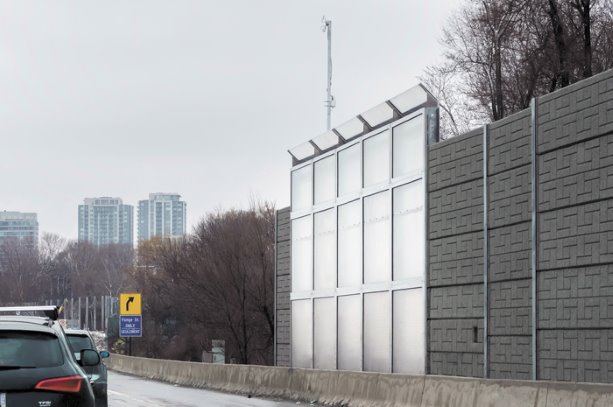The SmogStop Barrier is a new high tech solution designed to both reduce pollution and also act as a noise barrier alongside busy roads.
Created by Guelph, Ont.-based Envision SQ, the barrier is being licensed by distributor Armtec LP and is currently being tested in a pilot project by the Ontario Ministry of Transportation (MTO).
The barrier is made of acrylic, coupled with a proprietary photocatalytic coating that reacts with sunlight to capture smog-producing nitrogen oxides (NOx) and volatile organic compounds. The pollutants are then reduced to harmless atmospheric gases such as nitrogen and oxygen. The product also incorporates an acrylic noise barrier developed by Evonik.
"MTO had already tried a pilot barrier project designed to eliminate smog, but I explained to them why it wasn’t going to work," says Scott Shayko, Envision’s president and CEO. "The aerodynamics of the previous design didn’t allow the polluted air to come in contact with the photocatalytic material. Instead, polluted air flowed overtop the barrier."
SmogStop’s patented aerodynamic design funnels polluted air into a double-walled chamber. Vortex generators push the air violently against the interior wall, where it’s treated by the photocatalytic coating. The outside wall is transparent, allowing sunlight to activate the chemical process. The air is also directed upwards where it mixes with cleaner air, diluting pollution and directing it away from surrounding neighbourhoods.
Prototypes of the barrier were successfully tested at the University of Western Ontario’s wind tunnel. Full-scale testing was conducted at the University of Ontario Institute of Technology’s tunnel in Oshawa. Tests modelled both the aerodynamics of the design and its ability to reduce NOx in sunlight and non-sunlight conditions.
Previous smog barrier designs relied primarily on nanoparticles of titanium dioxide to chemically reduce pollution.
"But titanium dioxide has its limitations," says Shayko. "It only works well in UVB sunlight, but not so well in the visible light spectrum. Also, the byproduct of the chemical reaction contains liquids and solids that form a scale on the surface of the barrier, inhibiting further reaction. SmogStop’s proprietary coating leverages a reduction reaction that eliminates those byproducts. We expect it would operate for 10 years before it needs to be replenished."
Envision’s chief technology officer, Dr. Xin Qiu, worked to develop the coating technology, which not only combats tailpipe pollution, but also the secondary products of that pollution, which form regional smog and haze.
SmogStop barriers are built as a modular system. The acrylic panels are framed by aluminum and are lowered by crane into tracks located between steel posts. The backs of the panels are treated with a superhydrophilic coating that repels dust and particles. Shayko ballparks the current cost of the SmogStop Barrier at about two to three times that of a concrete barrier with similar dimensions. But the benefits outweigh the increased cost, he says.
"Very conservatively, one kilometre of SmogStop Barrier at five metres high will reduce 16 tonnes of NOx per year," says Shayko. "In terms of economic benefit, we see $10.4 million in savings for the government, largely health care savings, so payback is less than a year."
MTO’s pilot project is located on the north side of Highway 401 near Bayview Avenue in Toronto. Both Powell Contracting and Brennan Paving and Construction collaborated on the installation.
"The University of Guelph has developed the air monitoring protocol that will be used to assess air quality," says Shayko. "We’ll be measuring air quality at the bottom of the channel and the top of the channel and recording the difference. The most difficult part of the installation was getting power to the site to run the air monitoring equipment."
Data collected from the field test will be analyzed on an ongoing basis, with final results to be released in 2018.



Recent Comments
comments for this post are closed